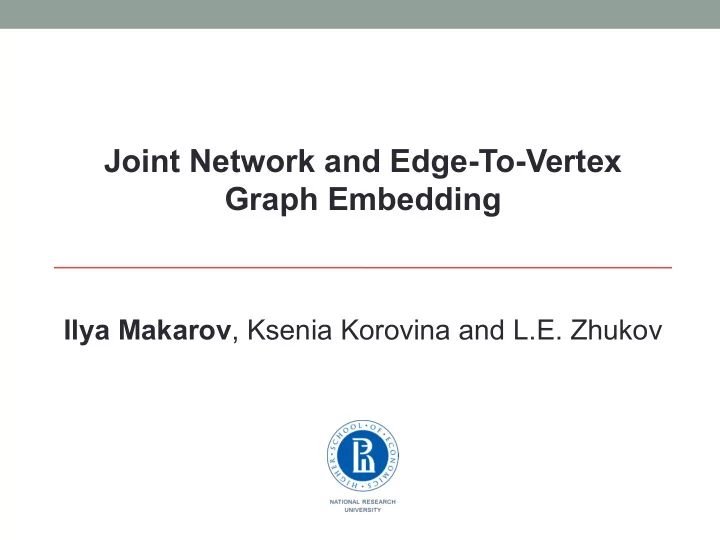

Joint Network and Edge-To-Vertex Graph Embedding Ilya Makarov , Ksenia Korovina and L.E. Zhukov
Our survey • We consider new formulation of graph embedding algorithm , while learning nodes and edges vector representation under common constraints. • We evaluate our approach on link prediction stated as a binary classification on features of pairs of nodes, and show performance on other ML problems on graphs. • We compare our model with existing structural and attributive network embeddings .
Node emdedding ❏ Machine learning on graphs require feature engineering of relational data. ❏ Mostly, manual feature engineering made by domain expert for particular problem was made. ❏ Nowadays, methods of automated task-independent graph feature engineering found wide broad of applications for machine learning problems on graphs.
Node emdedding http://snap.stanford.edu/proj/embeddings-www/ Definition Graph embedding is a mapping from a collection of substructures (most commonly either all nodes, or all edges, or certain subgraphs) to We will mostly consider node embeddings:
Node emdedding
Node embedding
Random-walk Node emdedding
Graph CNN
Edge Embeddings For edge embedding authors applied specific component-wise functions representing edge to node embeddings for source and target nodes of a given edge.
Link prediction Usually formulated as binary classification task , we take certain percentage of edges as positive examples, and use negative sampling for negative ones. Baseline in this task is shown in the Table:
Our Model: Preliminaries Definition Given a graph G = (V; E) defined as a set of vertices V and a set of edges E, we denote by G* = (V*; E*) Edge-to-vertex Dual (Line) graph, the nodes of which are the edges of G and edges are nodes, so that two adjacent nodes are connected by an edge if corresponding edges have a common node incident to them. Definition The first-order proximity describes the proximity between vertices presented by edge weight Aij . A neighborhood of vertex is defined as a set of vertices adjacent to it (vertex itself is not a part of its neighborhood). The second-order proximity between a pair of vertices describes the similarity measure between their neighborhood structures with respect to a selected proximity measure.
Our Model • Coupled graph autoencoders for G and G* • Structural feature generation • Joint loss constraint for embeddings for G and G* • Regularizations • Support weights, attributes, labels for both, nodes and edges
Our Model: Input and Feature Generation
Our Model: Graph Autoencoders
Our Model: Graph Autoencoders
Our Model • X0,X*0 - original node/edge features • X1,X*1 - learned sequential features • F, F* - embedding vectors • A^,A*^ - reconstructed adjacency matrices •
Our Model: Loss Function Reconstruction loss: Laplacian Regularization: Joint constraint: Model loss (C*=0):
Datasets
Evaluation on Link Prediction
Evaluation on Node Classification Evaluation on Clustering and Visaulizaiton
Conclusion In our research we ✓ present new graph embedding model for join node and edge optimization problem; ✓ we verify the quality of our approach on link prediction problem and conduct experiments on node classification, clustering and visualization; ✓ we will evaluate our model in semi-supervised framework: joint constraint prove to improve basic GCN performance; ✓ we aim to further study methods of joint network node and edge embedding methods and compare with existing models, such as ELAINE, LANE, Dual-Primal GCN and Edge-to-vec.
THANK YOU FOR YOUR ATTENTION! iamakarov@hse.ru
Recommend
More recommend